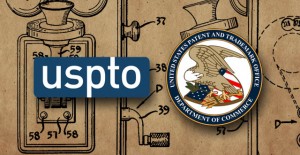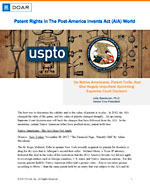Source of article DOAR Litigation Consulting.

On Native Americans, Patent Trolls, And
One Hugely Important Upcoming Supreme Court Decision
Julie Blackman, Ph.D.
Senior Vice President
The best way to determine the validity and so the value of patents is in play. In 2012, the AIA changed the rules of the game, and the value of patents changed abruptly. An upcoming Supreme Court decision may roll back the changes that have followed from the AIA. In the meantime, certain Native American tribes have profited more; patent trolls less.
Native Americans: The AIA Does Not Apply
(Source: New Yorker, November 20, 2017, “The Financial Page: Patently Odd” by Adam Davidson)
The St. Regis Mohawk Tribe in upstate New York recently acquired six patents for Restasis, a drug for dry eyes that is Allergan’s second-best seller. Michael Shore, a Texas IP attorney, brokered this deal in the wake of his realization that the 2012 America Invents Act did not apply to sovereign entities such as foreign countries, U.S. states and Native American nations. For this reason, patents held by Native American tribes had a greater value – four to ten times greater, according to Shore — than the same patent held by an entity that was subject to the AIA and its new inter partes review (a procedure for deciding patent challenges by the US Patent and Trademark Office
Allergan’s Restasis patents were being challenged by generics manufacturers Mylan and Teva. Allergan’s monopoly was worth more than a billion dollars a year. Allergan entered into a deal with the St Regis Mohawk tribe in which the tribe agreed to lease the patent back to Allergan exclusively for $15 million a year plus $13.75 million up front.
Last month, a federal judge in Texas ruled that some of Allergan’s Restasis patents were invalid. The judge commented, “sovereign immunity should not be treated as a monetizable commodity.” Some members of Congress led by Senator Claire McCaskill are calling for the abrogation of Native American sovereign immunity in patent claims cases. If Congress limits tribal immunity, Shore says that he could shift the patent portfolios to state universities. Shore is talking with historically black colleges and universities. He says that as long as there is money to be made in gaming the system, he thinks the money should go to those who need it most. Perhaps Shore is the Robin Hood of patent related activity but it seems unlikely that such gamesmanship truly serves the underlying value of patent monopolies as rewards and incentives for future work to inventors who share their inventions with a grateful public.
Patent Trolls Get Less Under AIA
(Source: New York Times, November 22, 2017, “Patent Trolls May Be Poised For Comeback.” Eduardo Porter’s Economic Scene Column)
New York Times commentator Eduardo Porter critiques patentees, especially pharmaceutical companies, who seek patent protection for changes to existing inventions that are not truly patent-worthy. Changes in dosages for example (e.g., Teva sought to patent the method of administering a 40-milligram dose three times a week for its blockbuster multiple sclerosis drug Copaxone to keep generics off the market long after its original patent expired) do not respect the intended value of a legal monopoly. No one should patent what the public has already had access to.
According to Joshua Landau, patent counsel at the Computer and Communications Industry Association, the Patent Trial and Appeal Board (PTAB) has saved companies more than $2 billion in legal fees alone by offering a quick and inexpensive route to contesting patent validity. Patent trolls’ demands have changed: “Now they sue and ask for $50,000 rather than sue and ask for $1 million,” says Mark Lemley, a law professor at Stanford. Thus, broader benefits obtain from invalidating bad patents. Porter wrote:
“Companies no longer have to pay ransom so the threat of lawsuits over dubious royalty payments – filed by aggressive litigants know as trolls – will go away. Consumers will no longer have to pay for bogus intellectual property covering, say, a method to take their pills. The appeal board [of the USPTO] has rejected questionable patent claims over technology to clean up polluted groundwater and wastewater, over podcasting, and over a system that Los Angeles wanted to introduce that looks a lot like E-Z Pass.”
Porter appeals to the Supreme Court, which is about to rule on two patent cases in this term, to stay tough on questions of patent validity. He would have the Court believe that striking down bad patents is not about taking property rights from the patentee but about realizing that those property rights ought not to have been awarded in the first place.
One Hugely Important Case Under Consideration By The Supreme Court: Are Inter Partes Reviews Unconstitutional?
(Source: Law360 Trials, Up Next At High Court: AIA Reviews & Whistleblower Shields,” November 26, 2017, Jimmy Hoover)
The inter partes review process established by the AIA is currently under intense consideration by the Supreme Court. Two cases will be decided this term. The implications of one of these cases is huge; the other involves a lawsuit in pursuit of clarification of the inter partes review that depends on the outcome of the first.
Oil States Energy Services v. Greene’s Energy Group
The constitutionality of inter partes reviews is at the heart of this case. Oil States’ hydraulic fracturing patent was found invalid by an AIA inter partes review initiated by Greene’s. Oil States is arguing that patents are private property rights that can only be revoked by an Article III court, not by a government agency like the patent office, and that the PTAB violates the Constitution’s separation of powers.
The new proceedings created by the AIA have been hugely popular with patent challengers. According to Law360, “since the law was enacted the PTAB (Patent and Trademark Appeals Board) has received more than 7,000 petitions challenging patents and has issued over 1,300 decisions invalidating patent claims, according to statistics compiled by the board.”
While accused infringers are delighted at easily achieved findings of invalidity, patent owners are not. This case reflects patent owners’ view that the new review process is destructive to legitimate patent rights. If Oil States wins, and the inter partes review is found to be unconstitutional, the heart of the AIA will stop beating.
SAS Institute Inc. v. Matal
This second case will only make sense if the Supreme Court decides that the PTAB review is valid. The case brought by SAS seeks a clarification of the procedure: Does the AIA require the PTAB to issue a final decision on all the reasons that an accused infringer raises to challenge patent claims, or is it sufficient for the board to issue its decision based only on those grounds that are likely to succeed?
SAS challenged all 16 claims of a ComplementSoft LLC computer code patent in an inter partes review but only received a final written decision on some of those.
Commentary
Patent law may be arcane; inventive technologies are complicated. And, yet, throughout our history, we have relied upon ordinary Americans to decide most patent disputes. Only in the wake of the AIA have we seen legislators side with those who would have an administrative board resolve the fine points that characterize patent matters. Our long history of empowering jurors to decide our most difficult legal cases is consistent with our deeply held respect for democracy.
The right to pursue profits – capitalism – is another deeply held value in the US and patents have long been treated as highly valuable commodities. Respect for democracy and egalitarianism are countered by the “winner take all” approach that drives capitalism. Patents provide a compelling test ground for the battle waged over the competing interests that follow from valid patents. How much novelty is required before a patent application is seen as different enough from the prior art to qualify for the economic boon that may follow from a period of guaranteed exclusivity? Who should decide? And, who should be able to profit from intellectual property?
Patent trolls have transformed the monetizing of intellectual property rights. I suspect that the impact of Native American tribes on portfolio ownership will be more limited in scope. Even so, these events provide context for the cases recently argued before the Supreme Court. We await word on whether the PTAB will retain the power granted them under the AIA, or whether the power to decide patent validity will once again be placed in the hands of ordinary Americans.
The post Patent Rights In The Post-America Invents Act (AIA) World appeared first on DOAR.

